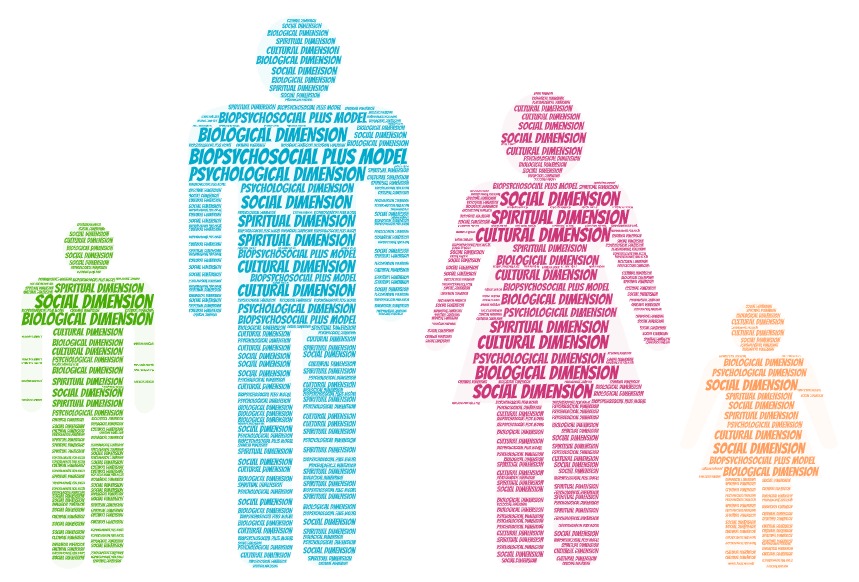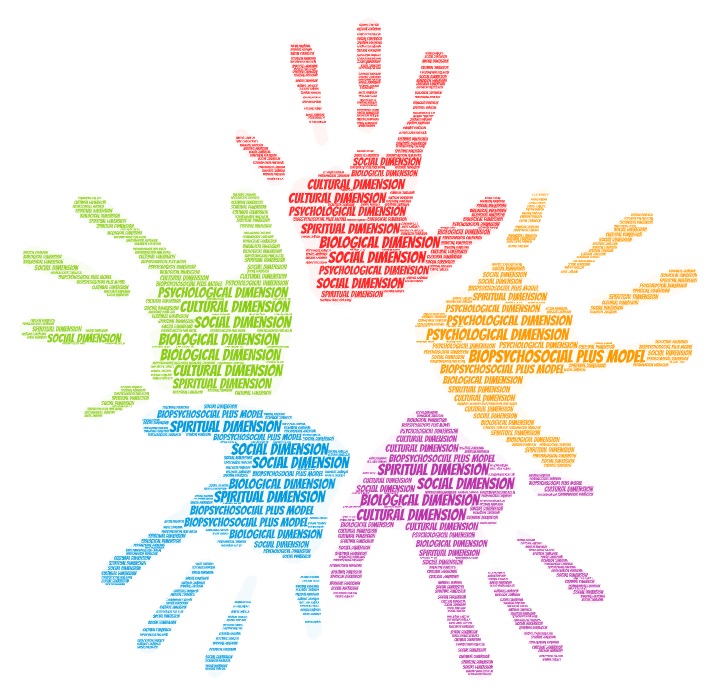9.3 Biopsychosocial Plus Model

Substance use disorders / Addictions as a Biopsychosocial Plus phenomenon
Reflect on the theories you have explored this far. As you have come to understand, to look at substance use disorders in a binary fashion, choosing one lens or another is not effective. Breaking down substance use and connecting it to biological factors, psychological factors, and social factors can help provide Social Service workers an opportunity to see a “whole” person and to provide wrap-around supports that can help a person meet their individual goals related to their substance use. You can further explore poverty, race, gender, and other examples of intersectionality that may play a role in a person’s substance use as you are working with them, ensuring your work is culturally and gender sensitive.
It is important to note substance use disorders do not often have one-specific cause. You may use a combination of theories to help your clients explore why they use substances and why they continue to use substances, are increasing substance use, or choosing to change their substance use, remembering you are not diagnosing. Using theories may help you understand the complexity of substance use and why one theory is generally not enough.
Attribution:
Exploring Substance Use in Canada by Julie Crouse is licensed under a Creative Commons Attribution-NonCommercial-ShareAlike 4.0 International License, except where otherwise noted.
Let’s watch The Science of Addiction – A Different Lens.
The Science of Addiction – A Different Lens. By Monash University. Why do people succumb to drug, alcohol, gambling and food addictions? Today, the science behind addiction is playing a bigger role in understanding why people become addicted and how to curb these dangerous behaviours. While society often continues to stigmatise addiction, we now know that it is a neurological condition. This has resulted in cutting edge treatments, better education, and significant research that is disrupting the exploitation of addicts by the tobacco, gambling and fast food giants.(1)
Transcript

When we see substance use disorders/addictions in a binary fashion, we are choosing one lens or another, which does not give us a clear picture of the person. When we look at substance use/addictions through a Biopsychosocial Plus model by connecting to biological, psychological, social, cultural and spiritual dimensions then we can as a social/mental health/addictions worker take an opportunity to see a “whole” person and be able to provide wrap-around supports that can help a person meet their individual goals related to their substance use/addiction. You can further explore poverty, race, gender, and other examples of intersectionality that may play a role in a person’s substance use/addiction as you are working with them, ensuring your work is cultural, spiritual, gender-sensitive and trauma-informed.
It is important to note substance use disorders/addiction do not often have a one-specific cause. You may use a combination of theories to help your clients explore why they use substances, why they continue to use substances, the increasing substance use, or choosing to change their substance use, always remembering you are not diagnosing and they are the expert in their journey. Using all these theories may help you understand the complexity of substance use and why one theory/lens is generally not enough
Whole Person Healthcare | The Biopsychosocial Spiritual Model of Medicine. By Doodle Med.(2)
Transcript
To Access the Video Transcript:
1. Click on “YouTube” on the bottom-right of the video. This will take you directly to the YouTube video.
2. Click on the More Actions icon (represented by three horizontal dots)
3. Click on “Open Transcript”

Biopsychosocial Plus Model
Biological Dimension

It is important not to look at the biological dimension as neurobiology alone. It also takes into consideration aspects of health functioning such as addictive behaviour, diet, exercise, self-care, nutrition, sleep and genetics. We look at all aspects of health, whether it is positive, neutral or challenging. Understanding the impact this information has on the person as well as the additive behaviour gives us a clearer picture for positive changes and for the person to actively participate in their recovery and treatment plan.
It is important not to look at the biological dimension as neurobiology alone, but to also take into consideration aspects of health functioning such as addictive behaviour, diet, exercise, self-care, nutrition, sleep and genetics. What is present, what is missing and what could be added.
The Biological Dimension Considers:
• Genetic factors that influence the variability of addiction
• Pharmacological solutions for treating addiction (overdose to pharmacotherapy)
• Effects on the body
• Importance of nutrition, sleep, and exercise
Psychological Dimension

The mind is to the psychological dimension what the brain is to neuroscience. The term “psychology” refers to a behavioural process that relates to motivation, emotions, mood, or the mind. Informed by science, many psychological models, govern our understanding of addiction. When we look at classical and operant conditioning to social learning theory, the transtheoretical model and the behavioural perspective we can see how the psychological dimension strongly affects addiction. All these areas contribute to the Psychological Dimension and what motivates the reward system.
When we look at the psychological dimension, it also allows us to understand and work more effectively in helping individuals, families and communities thrive and flourish in a positive way. When we understand the impact of our perception, purpose of rewards, motivation, expectancy, and maturation, it helps us to find solutions to the addictive behaviours that may not have been an option previously. It allows for the development of more positive behaviours by understanding alternatives, and more possibilities and gives opportunities for making positive decisions with those options.
Some refer to addiction as the disorder of choice.
The Psychological Dimension considers:
• Thoughts, feelings, and behaviours surrounding and generated by misuse (triggers)
• Early and persistent problem behaviours
• Issues related to trauma, victimization, and extreme stress experiences
• Motivators to reduce or stop drug use
Social Dimension

The social dimension is considered to be vitally important, it is the immediate interpersonal domain that is most proximal to the person who develops an addictive disorder. Who is in the social dimension includes, family, friends, workplace, social, exercise, the community of choice, leisure companions and faith community. It also takes into consideration the socio-structural perspective of the individual as it relates strongly to the many decisions that are made around addictions. This also takes into consideration the social determinants of health, social factors, culture, age, gender and other stressful situations that were experienced.
The Social Dimension considers:
• Family and family-of-choice relationships (interpersonal)
• Class, race, age and gender
• Early life exposures to stressful situations, such as conflict, hunger, violence and prejudice
• Association with alcohol and drug users
Cultural Dimension

Culture is very personal and we need to allow it to be whatever the person identifies it as. Culture is a missing piece and very important to those who have an addiction. It may have been lost, not yet experienced, which leaves a person feeling like there are missing pieces. Sometimes it is by choice, or experience, a negative representation of what they believed culture meant. It is important to be aware of the importance of understanding the client’s cultural belief system as they feel it is, through their eyes.
Culture is different for everyone, even if they were brought up in the same environment. It is what the person feels it is or is not. It is also connected to the spiritual dimension.
The Cultural Dimension considers:
• Community, race, gender, disabilities, etc.
• Association or disassociation from culture and community has an impact
• The client’s cultural belief system
Spiritual Dimension

Spiritual Dimension is very personal to people. You will hear about the importance of spirituality to people, whether it is religious or non-religious. It is very important to be respectful around all spiritual dimensions as it is very important to people. Think of it as the therapeutic imagination of what spirituality means to the individual and show respect to each person, so that they can have the freedom to find, explore, revisit or discover their own beliefs. It is a very personal, powerful journey and individual to all.
Spirituality affects our mental health as well as our well-being. It is important to allow them the journey of peer support, mutual aid, culture, nature, and spirituality to find their own spiritual dimension and it’s important to them.
The Spiritual Dimension considers:
• Personal perceptions and beliefs
• Spiritual and religious beliefs by which people live
Biopsychosocial Plus Model Activity:
The Biopsychosocial Plus Model is a very effective tool when working with mental health and addictions. Do you see it as a model you would use? Where and when would you use it? Do you feel that one specific area would be easier for you to support or would have a stronger effect on a person?

For more Information to Explore:
Key Takeaways
- Addiction is a multi-dimensional problem
- Recovery requires long-term solutions that address biological, psychological, social, cultural and spiritual concerns
ATTRIBUTION: This chapter is not covered by the adaptation statement, it is an original work, except for 2 first paragraphs which are by Exploring Substance Use in Canada by Julie Crouse is licensed under a Creative Commons Attribution-NonCommercial-ShareAlike 4.0 International License.
References
- Monash University. (2018, May 29). The Science of Addiction – A Different Lens [Video]. YouTube. https://www.youtube.com/watch?v=eWyoqGFyjHA
- Doodle Med. (2020, August 8). Whole Person Healthcare | The Biopsychosocial Spiritual Model of Medicine [Video]. YouTube. https://www.youtube.com/watch?v=XFTS6YWgnBk
- Curtis Lehmann. (2020, September 5). The Biopsychosocial-Spiritual Model [Video]. YouTube. https://www.youtube.com/watch?v=Kc3zv52uP7c
- Giordano, A. L., PhD. (2021, July 10). What Exactly Is the Biopsychosocial Model of Addiction? Psychology Today. https://www.psychologytoday.com/ca/blog/understanding-addiction/202107/what-exactly-is-the-biopsychosocial-model-addiction#:~:text=The%20biopsychosocial%20model%20of%20addiction%20provides%20a%20holistic%2C%20multifaceted%20conceptualization,risk%20of%20addiction%20among%20individuals.

